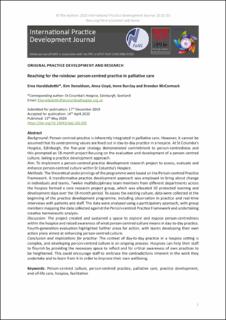| dc.contributor.author | Haraldsdottir, Erna | |
| dc.contributor.author | Donaldson, Kim | |
| dc.contributor.author | Lloyd, Anna | |
| dc.contributor.author | Barclay, Irene | |
| dc.contributor.author | McCormack, Brendan | |
| dc.date.accessioned | 2021-03-26T11:08:29Z | |
| dc.date.available | 2021-03-26T11:08:29Z | |
| dc.date.created | 2021-03-24T14:52:44Z | |
| dc.date.issued | 2020 | |
| dc.identifier.citation | Haraldsdottir, E., Donaldson, K., Lloyd, A., Barclay, I., & McCormack, B. (2020). Reaching for the rainbow: Person-centred practice in palliative care. International Practice Development Journal, 10(1). | en_US |
| dc.identifier.issn | 2046-9292 | |
| dc.identifier.uri | https://hdl.handle.net/11250/2735700 | |
| dc.description.abstract | Background: Person-centred practice is inherently integrated in palliative care. However, it cannot be assumed that its underpinning values are lived out in day-to-day practice in a hospice. At St Columba’s Hospice, Edinburgh, the five-year strategy demonstrated commitment to person-centredness and this prompted an 18-month project focusing on the evaluation and development of a person-centred culture, taking a practice development approach. Aim: To implement a person-centred practice development research project to assess, evaluate and enhance person-centred culture within St Columba’s Hospice. Methods: The theoretical underpinnings of the programme were based on the Person-centred Practice Framework. A transformative practice development approach was employed to bring about change in individuals and teams. Twelve multidisciplinary team members from different departments across the hospice formed a core research project group, which was allocated 10 protected learning and development days over the 18-month period. To assess the existing culture, data were collected at the beginning of the practice development programme, including observation in practice and real-time interviews with patients and staff. The data were analysed using a participatory approach, with group members mapping the data collected against the Person-centred Practice Framework and undertaking creative hermeneutic analysis. Discussion: The project created and sustained a space to explore and expose person-centredness within the hospice and raised awareness of what person-centred culture means in day-to-day practice. Fourth-generation evaluation highlighted further areas for action, with teams developing their own action plans aimed at enhancing person-centred culture. Conclusion and implications for practice: The context of day-to-day practice in a hospice setting is complex, and developing person-centred culture is an ongoing process. Hospices can help their staff to flourish by providing the necessary space to reflect and for critical awareness of own practices to be heightened. This could encourage staff to embrace the contradictions inherent in the work they undertake and to learn from it in order to improve their own wellbeing. | en_US |
| dc.language.iso | eng | en_US |
| dc.rights | Navngivelse-Ikkekommersiell 4.0 Internasjonal | * |
| dc.rights.uri | http://creativecommons.org/licenses/by-nc/4.0/deed.no | * |
| dc.title | Reaching for the rainbow: person-centred practice in palliative care | en_US |
| dc.type | Peer reviewed | en_US |
| dc.type | Journal article | en_US |
| dc.description.version | publishedVersion | en_US |
| dc.rights.holder | © The Authors. | en_US |
| dc.source.volume | 10 | en_US |
| dc.source.journal | International Practice Development Journal | en_US |
| dc.source.issue | 1 | en_US |
| dc.identifier.doi | https://doi.org/10.19043/ipdj.101.005 | |
| dc.identifier.cristin | 1900715 | |
| dc.source.articlenumber | 5 | en_US |
| cristin.ispublished | true | |
| cristin.fulltext | original | |
| cristin.qualitycode | 1 | |

